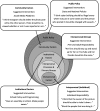Ideas for addressing electronic harassment among adolescents attending a video blogging convention
- PMID: 30081876
- PMCID: PMC6080490
- DOI: 10.1186/s12889-018-5907-6
Ideas for addressing electronic harassment among adolescents attending a video blogging convention
Abstract
Background: Electronic harassment affects 20-40% of adolescents and has been associated with significant negative outcomes including physical (ex. headache, abdominal pain), psychological (ex. depression, anxiety), and psychosocial (ex. school avoidance) problems. Evidence-based strategies to address electronic harassment are lacking, and few studies have incorporated adolescent input into intervention design. The purpose of this study was to use a novel data collection approach to determine perspectives on electronic harassment intervention and prevention from a targeted group of highly engaged adolescent technology users.
Methods: We conducted a qualitative survey of a purposeful sample of adolescents age 14 to 18 who were attending a video blogger convention in Seattle, Washington. Participants were approached by research staff and asked to read a vignette about an adolescent target of electronic harassment, then write down ideas for helping the target and/or preventing the scenario. Written responses were analyzed using a thematic analysis approach with an iterative comparative method to resolve any code discrepancies. We subsequently categorized codes into thematic code families to reach consensus about significant themes.
Results: 67 eligible adolescents completed the survey. 91% of participants were female with a mean age of 15.3 years (SD = 1.3). Code families emerged regarding people who could be involved in responses to electronic harassment: (1) Individuals targeted by electronic harassment, (2) Friends and bystanders, (3) Adults, and (4) Social media websites and policymakers.
Conclusions: Findings demonstrate adolescent technology users' views on several creative strategies to prevent or intervene with electronic harassment. These strategies can be categorized using a socioecological framework, demonstrating potential to address electronic harassment on multiple levels. Many suggested responses involved the target of electronic harassment, rather than the perpetrator; future education efforts may require additional focus on perpetrators for more upstream prevention.
Keywords: Adolescents; Cyberbullying; Electronic harassment; Qualitative.
Conflict of interest statement
Ethics approval and consent to participate
This study was approved by the Western IRB (Study #1148416). A waiver of parental consent for this study was granted by Western IRB, and all participants followed the procedure of informed consent before participating in the study. A team of four investigators—two Adolescent Medicine physicians (Y.E. and E.S.) and two research assistants (A.T. and N.M.)—attended VloggerFair, where they approached attendees in line for booths and asked if they would be interested in participating in a short research study. After screening for age eligibility, recruiters obtained consent to participate in the study.
Consent for publication
Not applicable.
Competing interests
The authors declare that they have no competing interests.
Publisher’s Note
Springer Nature remains neutral with regard to jurisdictional claims in published maps and institutional affiliations.
Figures
References
-
- Smith PK, et al. Cyberbullying: its nature and impact in secondary school pupils. J Child Psychol Psychiatry. 2008;49(4):376–385. - PubMed
-
- Olweus D. Bullying at school: what we know and what we can do. Understanding children’s worlds. Oxford; Cambridge: Blackwell. xii; 1993.
-
- Hamm MP, et al. Prevalence and effect of Cyberbullying on children and young people: a scoping review of social media studies. JAMA Pediatr. 2015;169(8):770–77. - PubMed
-
- Beckman L, Hagquist C, Hellstrom L. Discrepant gender patterns for cyberbullying and traditional bullying - an analysis of Swedish adolescent data. Comput Hum Behav. 2013;29(5):1896–1903.
-
- Connell NM, et al. Badgrlz? Exploring sex differences in cyberbullying behaviors. Youth Violence Juvenile Justice. 2014;12(3):209–228.
Publication types
MeSH terms
Grants and funding
LinkOut - more resources
Full Text Sources
Other Literature Sources
Medical



